Rachel Carson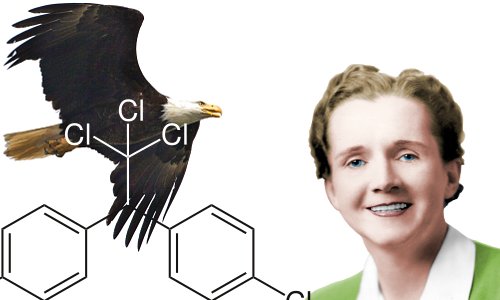
Lived 1907 – 1964.
Rachel Carson played a key role in birth of environmentalism in the 20th century. A zoologist by training, she resigned from the government’s Fish and Wildlife Service when her book The Sea Around Us became an award-winning bestseller. Her distinctive writing was both scientifically clear and linguistically evocative.
In the late 1950s, Carson became increasingly aware of the harmful effects of chemicals such as the insecticide DDT on the environment. This pushed her to write her most famous work Silent Spring and then defend herself against attacks from commercial interests while fighting a personal battle with cancer.
Silent Spring sold over 2 million copies, converting a large number of people to environmentalism. It also played an influential part in persuading governments to ban or heavily restrict the use of DDT and similar chemicals that persist in the environment.
Advertisements
Beginnings
Rachel Louise Carson was born on her family’s 64-acre homestead near the small town of Springdale, Pennsylvania, USA on May 27, 1907.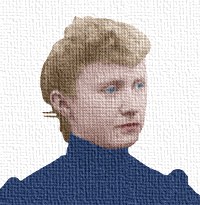
Rachel’s mother, who lived with Rachel for most of her life.
Her mother, Maria McLean, had been educated at an elite Presbyterian high school in Washington D.C. and was an accomplished singer and musician; before marriage she was a school teacher.
Rachel was the youngest of her parents’ three children – her sister Marian and brother Robert were ten and eight years older than her.
Although the Carson’s home had plenty of land, the family had very little money. Their home had no indoor plumbing and no electricity.
An Early Love of Nature and Reading
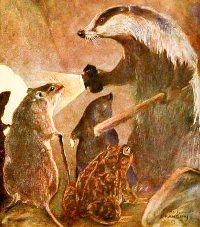
Characters from Wind in the Willows
Rachel fused her love of nature with a love of reading. Her preferred literature usually featured animals: her favorite author was Beatrix Potter, and her favorite story was Kenneth Grahame’s Wind in the Willows.
She loved the nature novels of Gene Stratton Porter and later the sea stories of Joseph Conrad.
Budding Writer Sells her Stories and is Top of Class
At about age eight, Rachel began writing stories.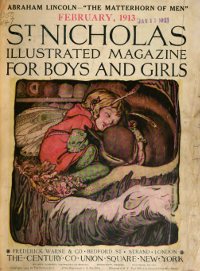
A copy of St. Nicholas
In May 1918, age 11, Rachel sent a story to the St. Nicholas League called A Battle in the Clouds. The story was inspired by a letter from her brother Robert, serving in the Army Air Service in France.
Rachel’s story was published four months later. By August 1919, St. Nicholas had published three more of her stories – all with military themes – and sent her $10.
Two years later, the magazine paid her a cent a word for a story so good they used it to generate publicity.
Meanwhile, at school in Springdale, Rachel scored straight As in her academic work. Her mother was determined to give her clever daughter a good enough education to allow her to achieve her full potential, something she was rather bitter about not achieving in her own life.
In 1923, age 16, Rachel started at Parnassus High School; two miles from Springdale, it was reputed to have excellent teachers. Rachel graduated first in her class in May 1925.
Parental Sacrifices and College
In the fall of 1925, Rachel became a freshman at the elite Pennsylvania College for Women in Pittsburgh, commonly referred to as PCW (now Chatham University). She won a $100 scholarship for tuition and another paying $100 for living expenses, but her tuition and boarding fees were almost $800.To fund their daughter, her cash-strapped parents subdivided and mortgaged some land and put it up for sale. Her mother gave piano lessons and did odd jobs for people in town.
Rachel did not make friends easily at college. She was seen as cool and detached. At weekends she either went home or her mother came to stay at college; her fellow students thought this was a strange and somewhat suffocating situation and they made fun of Rachel. Throughout her undergraduate years, she also suffered badly from acne on her face and shoulders.
In the end, Rachel made a handful of friends by helping people with their work. Her friends discovered she was not aloof. Although her behavior in classes was self-assured, she was actually shy about personal relationships and friendships.
 “I love all the beautiful things of nature and the wild creatures are my friends.”
“I love all the beautiful things of nature and the wild creatures are my friends.”
Rachel Carson
1925, Essay
Money Problems & Honors
After a year at college, Rachel had not paid her tuition fees fully. The college told her parents Rachel was doing so well that benefactors had paid her fees.Rachel had at first intended majoring in English and becoming a writer, but her love of the natural world triumphed and she majored in biology. She did not abandon writing though; she joined the college newspaper’s staff and wrote regularly for it.
She was one of only three students in the PCW class of 1929 who graduated magna cum laude (with great honor).
The Great Depression began two months after Rachel graduated.
Graduate School & More Money Problems
In the fall of 1929, Rachel Carson began graduate school at Johns Hopkins University in Baltimore, Maryland, studying zoology and genetics.Money was a major problem: she owed Pennsylvania College $1,600. After just a year at graduate school she abandoned full-time schooling to earn money as a laboratory assistant.
In June 1932, age 25, Carson graduated with a master’s degree in zoology.
She hoped to complete a Ph.D., but her parents, who had done so much to support her financially, could no longer keep the wolf from the door; they were in desperate straits themselves. Rachel signed over land around the family homestead at Springdale to PCW to clear her college debt.
She quit graduate school in 1934. The following year her father died at age 71.
A Full-time Job
Carson got a temporary job blending her skills in zoology and writing; she wrote radio scripts for the U.S. Bureau of Fisheries’ weekly educational broadcast: Romance Under the Waters. Bureau staff were delighted with Carson’s work. Her scripts received a much more enthusiastic response from listeners than any of her predecessors’ had.The Bureau requested she sit the civil service exam. She came top of the women candidates. In 1936, she became a junior aquatic biologist. She was grateful for the secure government job – hard to come by in the depression. Her finances were finally on firm ground.
Working full-time in Baltimore, Carson authored government pamphlets and studied fish populations. She also wrote freelance newspaper and magazine articles about the natural world – especially the oceans.
Carson wrote her first book Under the Sea-Wind in 1941. The critics loved it, but it received minimal publicity. Just a few weeks after it came out, the Japanese Navy launched a devastating attack on Pearl Harbor. In the ensuing turmoil, the American public lost its appetite for books about the natural world. Carson’s book was forgotten.
An Enormously Successful Author
Determined to succeed as an author, in 1948 Carson began planning a second book and engaged the services of a literary agent, Marie Rodell.Meanwhile, her work was earning an impressive reputation in the civil service. In 1949, she was appointed Chief Editor of Publications for the Fish and Wildlife Service.
Carson completed her book The Sea Around Us in 1950. The New Yorker serialized several chapters before the book’s release in July 1951.
The Sea Around Us was a stunning success. It held top spot on the New York Times Best Seller List for 39 weeks, selling over 250,000 copies in six months.
The following year brought Carson recognition on an impressive scale. First, she won the National Book Award for Nonfiction.
 “The aim of science is to discover and illuminate truth. And that, I take it, is the aim of literature, whether biography or history or fiction. It seems to me, then, that there can be no separate literature of science.”
“The aim of science is to discover and illuminate truth. And that, I take it, is the aim of literature, whether biography or history or fiction. It seems to me, then, that there can be no separate literature of science.”
Rachel Carson
1952, National Books Award Ceremony
Her forgotten first book was rediscovered, joining The Sea Around Us on the Best Seller List.
Requests for TV, radio, and newspaper interviews flooded in – most of which Carson politely declined. Fan mail arrived by the sackful and people began to recognize her in public places. She found the whole ‘celebrity’ business highly stressful.
Nevertheless, at age 45, she had finally reached the destination she dreamed of 34 years earlier: she was a successful author. She quit her government job in the summer of 1952.
A documentary based on The Sea Around Us won the 1953 Academy Award for Best Documentary Feature, but Carson believed it was inaccurate and did not reflect her work properly. It was the last time she sold film rights to any of her works.
Carson released her third book, The Edge of the Sea, and continued writing articles for magazines and newspapers.
Silent Spring and Environmentalism
Carson converted large numbers of people to environmentalism. She grabbed their attention with Silent Spring, her most influential book. Published in September 1962, it dealt powerfully with human-generated destruction of the natural world. Eventually, over 2 million copies sold.Carson was worried that chemicals such as DDT had been rushed into large-scale usage before anyone had researched their environmental effects. She sought to bring the world’s attention to evidence researchers were accumulating showing that pesticides were killing many more creatures than just their intended targets. These chemicals were being sprayed routinely over large tracts of land in America and elsewhere.
What is DDT?
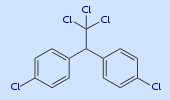
DDT’s chemical structure
In 1943, the U.S. Army sprayed over a million people with DDT in the Italian city of Naples, stopping a typhus epidemic in its tracks and saving countless lives.
DDT seemed to be a godsend, almost magical in its apparent benevolence. It was used in campaigns to rid North America and Europe of malaria in the late 1940s, killing its mosquito carriers.
Müller was awarded the 1948 Nobel Prize in Physiology or Medicine for his discovery of DDT’s effects.
By 1959, 40,000 tons of DDT were being sprayed every year on land in the USA.
There is no malign outside influence to blame for the disaster; the people have caused it themselves with their use of chemicals. The poisons they forced upon the environment have come back to attack them.
Carson notes that no single community she knows has suffered all these misfortunes, but the misfortunes she describes are real; they have all happened somewhere, and some towns have suffered multiple misfortunes.
 “As crude a weapon as the cave man’s club, the chemical barrage has been hurled against the fabric of life — a fabric on the one hand delicate and destructible, on the other miraculously tough and resilient, and capable of striking back in unexpected ways… It is our alarming misfortune that so primitive a science has armed itself with the most modern and terrible weapons, and that in turning them against the insects it has also turned them against the earth.”
“As crude a weapon as the cave man’s club, the chemical barrage has been hurled against the fabric of life — a fabric on the one hand delicate and destructible, on the other miraculously tough and resilient, and capable of striking back in unexpected ways… It is our alarming misfortune that so primitive a science has armed itself with the most modern and terrible weapons, and that in turning them against the insects it has also turned them against the earth.”
Rachel Carson
1952, Silent Spring
She was angry about the contamination of ecosystems, anger sharpened by her own plight: she wrote the book while suffering from terminal cancer.
 “Among the herbicides are some that are classified as ‘mutagens,’ or agents capable of modifying the genes, the materials of heredity. We are rightly appalled by the genetic effects of radiation; how then, can we be indifferent to the same effect in chemicals that we disseminate widely in our environment?”
“Among the herbicides are some that are classified as ‘mutagens,’ or agents capable of modifying the genes, the materials of heredity. We are rightly appalled by the genetic effects of radiation; how then, can we be indifferent to the same effect in chemicals that we disseminate widely in our environment?”
Rachel Carson
1952, Silent Spring
Enter the Government
The government could not ignore the controversy and public alarm provoked by Silent Spring.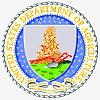 “Miss Carson provides a lucid description of the real and potential dangers of misusing chemical pesticides… She expresses the concern of many people about the effect of chemical pesticides on birds, animals and people. We are fully aware of and share this concern.”
“Miss Carson provides a lucid description of the real and potential dangers of misusing chemical pesticides… She expresses the concern of many people about the effect of chemical pesticides on birds, animals and people. We are fully aware of and share this concern.”
USDA Statement
July 1962
 “Yes… I think particularly since Miss Carson’s book, but they are examining the matter.”
“Yes… I think particularly since Miss Carson’s book, but they are examining the matter.”
President John F. Kennedy
August 29, 1962, Presidential News Conference
“…until the publication of Silent Spring, people were generally unaware of the toxicity of pesticides.”It concluded:
“…the accretion of residues in the environment can be controlled only by orderly reductions of persistent pesticides.”After much political infighting and resistance from the commercial sector, the use of DDT in agriculture was banned in the USA in 1972, greatly reducing harm to the environment. Numbers of America’s national bird, the bald eagle, which had fallen to just 500 nesting pairs in the contiguous USA in the 1950s have since recovered to about 100,000. DDT in the food chain had made the birds’ eggshells so fragile that they broke before the chicks were old enough to hatch.
The 2001 Stockholm Convention on Persistent Organic Pollutants banned DDT and other organochlorine pesticides for most uses worldwide. They they are still permitted for control of malaria. This would have suited Carson, who never proposed an outright ban – she wanted the indiscriminate use of pesticides halted.
Conclusion
Carson helped people see that our technology can cause planet-wide harm to ecosystems. Any harm we do has the potential to rebound on us. It is in our long-term interests to be cautious in our approach to the environment.Some Personal Details and the End
Carson never married and had no children. Her mother was always the most important person in her life, sharing her home and acting as her housekeeper and secretary. In their later years, they lived at the northern tip of Washington D.C in Silver Spring, Maryland.Carson’s elder sister Marian died of pneumonia in 1937. Marian’s husband had deserted her and their two daughters a few years earlier. Carson took the girls into her home. Carson’s mother, who was almost 70 years old, looked after them while Carson’s salary paid the bills. Carson and her mother cared for the girls until they were adults.
In 1952, following the success of The Sea Around Us, Carson had a cottage built on Southport Island, overlooking Sheepscot Bay on Maine’s coast. She and her mother spent summers there enjoying the sea and the shore, escaping Maryland’s heat and humidity. Their neighbors were Dorothy and Stanley Freeman. Carson was romantically attracted to Dorothy Freeman, and the two became close friends.
In 1957, aged 50, Carson adopted and became mother to her orphaned five-year-old grandnephew Roger Christie.
In December 1958, Carson’s beloved mother died at age 89.
In April 1960, Carson was hospitalized for removal of cysts from her left breast. The surgeon ended up performing major breast cancer surgery on her. She did not know it then, but she had only three years of life remaining.
In January 1963, Carson was diagnosed with heart disease – angina. The angina was no doubt caused by frequent high doses of radiation she was enduring to ward off breast cancer. However, cancer had now spread into her bones. She was now confined to a wheelchair. By March 1964, the cancer had spread to her liver. Her heart-condition greatly increased the risks of any procedures, but surgeons pressed on and surgically inserted a radioactive implant to attack the cancer. Carson returned to her home in Silver Spring on April 6.
Rachel Carson died of a heart attack on April 14, 1964 in Silver Spring, Maryland. She was 56 years old.
Half of her ashes were buried in her mother’s grave at Parklawn Memorial Cemetery in Rockville, Maryland, and the other half were scattered by Dorothy Freeman on the coast of Sheepscot Bay. Carson’s will provided generously for the future of her adopted son Roger Christie, who came under the guardianship of Carson’s close friend Paul Brooks, senior editor at Carson’s publishers Houghton Mifflin, and his wife Susie.
Advertisements
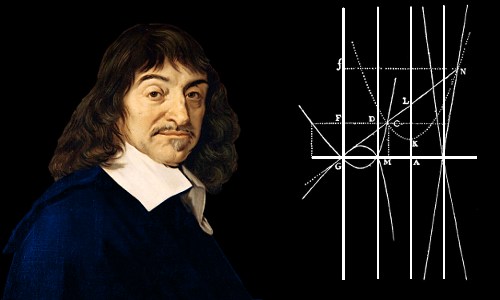
No comments:
Post a Comment